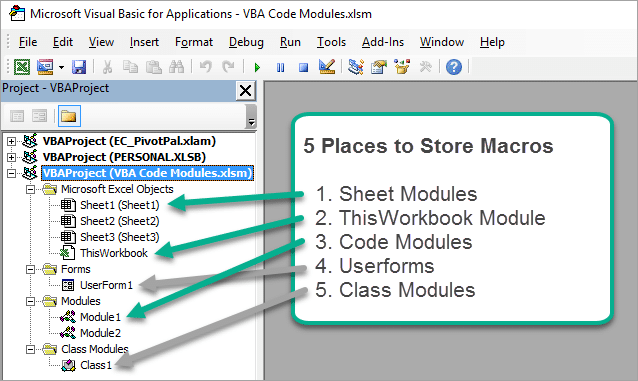

You can change both the sheet name and the code name in the property window of the sheet(see image below). In the image you can see that the code name is the name outside the parenthesis and the sheet name is in the parenthesis. If you look in the VBE property window you will see both names. The sheet name is the name that appears in the worksheet tab in Excel.Ĭhanging the sheet name does not change the code name meaning that referencing a sheet by the code name is a good idea. Each worksheet has a sheet name and a code name. The best method of accessing the worksheet is using the code name. To view this window select View->Immediate Window(or Ctrl G) In the example above, I used Debug.Print to print to the Immediate Window. Worksheets(.Worksheets.Count).Name End With End Sub Worksheets(3).Name ' Right most sheet Debug.Print. Worksheets(1).Name ' The third sheet from the left Debug.Print. The following code shows examples of using the index ' ' Using this code is a bad idea as ' sheet positions changes all the time Public Sub UseSheetIdx() With ThisWorkbook ' Left most sheet Debug.Print. As the position can easily be changed by the user it is not a good idea to use this. The index refers to the sheet tab position in the workbook. So far we have been using the sheet name to access the sheet. If you still have issues then use one of the loops from Loop Through The Worksheets section to print the names of all worksheets the collection. Workbooks( “book1.xlsx”).Worksheets(“Sheet1”) instead of Workbooks( “book3.xlsx”).Worksheets(“Sheet1”). You used Worksheets(5) but there are only four worksheets The worksheet name given to Worksheets is spelled incorrectly.This may happen for the following reasons This means you tried to access a worksheet that doesn’t exist. When you use Worksheets you may get the error: ThisWorkbook.Worksheets( "Sheet1").Unprotect Password:= "MyPass" ThisWorkbook.Worksheets( "Sheet1").Protect Password:= "MyPass" ' This is the only way to make a xlVeryHidden sheet visibleĪnother example of using the worksheet is when you want to protect it ThisWorkbook.Worksheets( "Sheet1").Visible = xlVeryHidden This means it can only be made visible by the code. If you want to prevent a user accessing the worksheet, you can make it “very hidden”. ThisWorkbook.Worksheets( "Sheet1").Visible = xlSheetVisible ThisWorkbook.Worksheets( "Sheet1").Visible = xlSheetHidden
Excel vba on open worksheet event how to#
The following examples show how to hide and unhide a worksheet Worksheets( "Sheet3").Range( "A1") = "Hello World" End Sub Worksheets( "Sheet2").Range( "A1") = "Hello World" Worksheets( "Sheet1").Range( "A1") = "Hello World" ' Worksheets refers to the worksheets in the active workbook If we don’t specify the workbook then the active workbook is used by default. The Worksheets collection is always belong to a workbook. ThisWorkbook.Worksheets( "Sheet3").Range( "A1") = "Hello World" End Sub ThisWorkbook.Worksheets( "Sheet2").Range( "A1") = "Hello World"

ThisWorkbook.Worksheets( "Sheet1").Range( "A1") = "Hello World" ' Public Sub WriteToCell1() ' Write To cell A1 In Sheet1,Sheet2 And Sheet3 The code below writes “Hello World” in Cell A1 of Sheet1, Sheet2 and Sheet3 of the current workbook. To get access to a worksheet all you have to do is supply the name. This collection is simply called Worksheets and is used in a very similar way to the Workbooks collection. There is an entry in this collection for each worksheet in the workbook. In VBA, each workbook has a collection of worksheets. With a worksheet, it either exists in the workbook or it doesn’t. With workbooks you may need to open them, find which folder they are in, check if they are in use and so on. Using Worksheets is more straightforward than using workbooks. However, you will mainly use it to perform some action on one or more cells on the worksheet. You may use it to protect, hide, add, move or copy a worksheet. The most common use of the worksheet in VBA is for accessing its cells. Of all the code your write, 90% will involve one or all of them. The three most important elements of VBA are the Workbook, the Worksheet and Cells. Worksheets.Add after:=Worksheets(Worksheets.Count) Otherwise the active workbook will be used by default.Īccess using worksheet code name(current workbook only)Īccess using worksheet code name(other workbook) You should always specify the workbook when using Worksheets. This is to make the examples clear and easy to read. Worksheets rather than ThisWorkbook.Worksheets, wk.Worksheets etc. Note: I use Worksheets in the table below without specifying the workbook i.e. The following table gives a quick run down to the different worksheet methods.



 0 kommentar(er)
0 kommentar(er)
